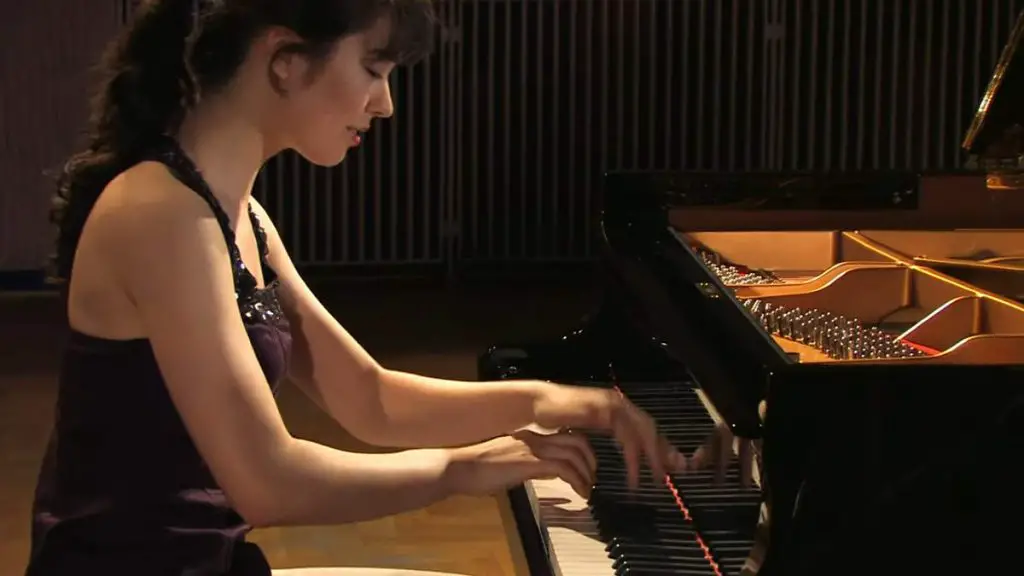Accompanied by the Orchestre Philharmonique de Radio France (Radio France Philharmonic Orchestra), German-Japanese classical pianist Alice Sara Ott performs Ludwig van Beethoven’s Piano Concerto No. 3 in C minor, Op. 37. Conductor: Mikko Franck. Live recording on January 27th, 2018, in the auditorium of Radio France (Paris).
Encore: Bagatelle No. 25 in A minor (WoO 59, Bia 515) for solo piano, commonly known as “Für Elise“, one of Ludwig van Beethoven’s most popular compositions.
Beethoven’s Piano Concerto No. 3
Beethoven composed this work in 1799-1800 and introduced it in Vienna on April 5, 1803. The first sketches go back to 1797 – after he’d composed the B flat Piano Concerto (published as No. 2), but before the
Although Beethoven played the first performance of No. 3 in 1803 from a short score – no one was going to steal it from him! – he’d actually completed the music prior to April 1800, apart from a few last-minute adjustments. In other words, before he wrote the Second Symphony (Op. 36), the Moonlight Piano Sonata (Op. 27/2), or the Op. 31
As is standard for Classical/Romantic-era concertos, the work is in three movements:
- Allegro con brio. This movement is known to make forceful use of the theme (direct and indirect) throughout.
- Orchestral exposition: In the orchestral exposition, the theme is introduced by the strings, and used throughout the movement. It is developed several times. In the third section (second subject), the clarinet and violin 1 introduce the second main theme, which is in the relative major key, E-flat major.
- Second exposition: The piano enters with an ascending scale motif. The structure of the exposition in the piano solo is similar to that of the orchestral exposition.
- Development: The piano enters, playing similar scales used at the beginning of the second exposition, this time in D major rather than C minor. The music is generally quiet.
- Recapitulation: The orchestra restates the theme in fortissimo, with the wind instruments responding by building up a minor ninth chord as in the exposition. For the return of the second subject, Beethoven modulates to the tonic major, C major. A dark transition to the cadenza occurs, immediately switching from C major to C minor.
- Cadenza: Beethoven wrote one cadenza for this movement. The cadenza Beethoven wrote is at times stormy and ends on a series of trills that calm down to pianissimo. Many other composers and pianists have written alternative cadenzas.
- Coda: Beethoven subverts the expectation of a return to the tonic at the end of the cadenza by prolonging the final trill and eventually arriving on a dominant seventh. The piano plays a series of arpeggios before the music settles into the home key of C minor. Then the music intensifies before a full tutti occurs, followed by the piano playing descending arpeggios, the ascending scale from the second exposition, and finally a resolute ending on C.
- Largo. The second movement is in the key of E major, in this context a key relatively remote from the concerto’s opening key of C minor (another example being Brahms’s first symphony.). If the movement adhered to traditional form, its key would be E-flat major (the relative key) or A-flat major (the submediant key). The movement opens with the solo piano and the opening is marked with detailed pedaling instructions.
- Rondo. Allegro. The finale is in sonata-rondo form. The movement begins in C minor with an agitated theme played only by the piano. The movement ends with a C major coda marked Presto.
Alice Sara Ott
Alice Sara Ott (born 1988) is a German-Japanese classical pianist. She was born in Munich, Germany, in 1988; her Japanese mother had studied piano in Tokyo, and her father was a German civil engineer. At the age of three, after being taken to a concert, she decided she wanted to become a pianist; as she says, she realized that “music was the language that goes much beyond any words” and that she wanted to communicate and express herself through music. She started piano lessons when she was four, and reached the final stage of the youth competition in Munich at the age of five, playing to a full house in the Hercules Hall.
From the age of twelve, she studied at the Salzburg Mozarteum with Karl-Heinz Kämmerling while continuing her school education in Munich. Ott has won awards at a number of piano competitions, including first prize at the 2004 Pianello Val Tidone Competition. She has made recordings of Franz Liszt’s Transcendental Etudes and Frédéric Chopin’s waltzes for Deutsche Grammophon, and is currently performing concert tours in Europe, Japan, and the United States.
She has gained critical acclaim for her performances at major concert halls worldwide and has established herself as one of the most exciting musical talents of today. The Guardian, commenting on her recent performance with the London Symphony Orchestra, said that she “gave the kind of gawp-inducing bravura performance of which legends are made.”
Alice has worked with the world’s leading conductors, including Lorin Maazel, Paavo Järvi, Neeme Järvi, James Gaffigan, Sakari Oramo, Osmo Vänskä, Vasily Petrenko, Myung-Whun Chung, Hannu Lintu and Robin Ticciati.
Ott has won many international competitions since winning the Jugend
Sources
- Alice Sara Ott on Wikipedia
- Alice Sara Ott official website
![Beethoven: Piano Concerto No. 3 [Alice Sara Ott]](https://cdn-0.andantemoderato.com/wp-content/uploads/2018/12/Alice-Sara-Ott-Beethoven-Piano-Concerto-No-3-1568x882.jpg)


![Beethoven: Piano Concerto No. 3 [Alice Sara Ott]](https://cdn-0.andantemoderato.com/wp-content/uploads/2018/12/Alice-Sara-Ott-Beethoven-Piano-Concerto-No-3-1024x576.jpg)
